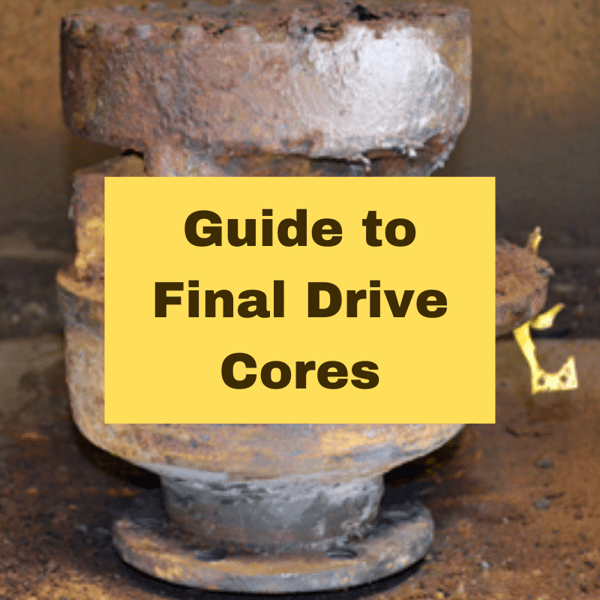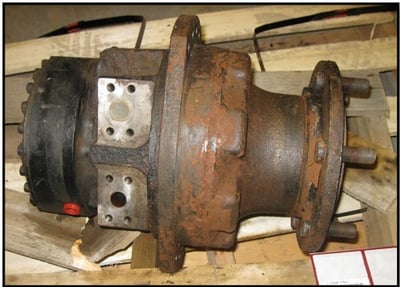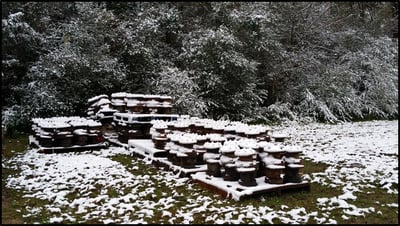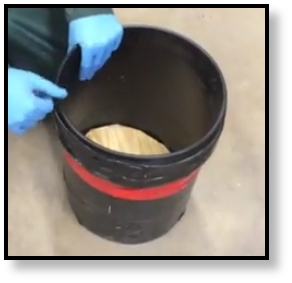What are final drive core exchange policies? How does a core buyback work? What final drive cores are usually in demand? What condition do they need to be in? We try to answer these questions in more in this latest Shop Talk Blog post.

Here are some other blog posts you might find helpful:
- Bobcat 325 Rotator Group Damage
- Rebuilding a Track Drive
- Two-Phase Testing and Quality Assurance for Final Drives
Why Are Travel Drive Cores Important?
The word "core" refers to a used final drive that is being replaced. As long as the housing, ports, and flange are in good condition, there's a good chance that the core can be salvaged and used for a rebuild. While the inside of the drive motor might be in terrible condition, the housing could be used for a remanufactured final drive (especially for final drives that aren't manufactured anymore).

This is an ugly final drive core, but don't let appearances deceive you.
But that exterior core must me certain conditions. For example, it must be without cracks or signs of mechanical failure, threads must be intact, and the flanges cannot be bent. And in many cases, there are parts within the core that can be repurposed after cleaning, inspection, and reconditioning (with the exception of seals, gaskets, and bearings, however). On the other hand, exterior rust and encrusted debris is not the same as damage. That can be cleaned and removed. Rather, core damage refers to issues such as broken threads, cracks in the housing, and missing parts of the housing.
Valuable Final Drive Cores
So what makes a final drive core valuable? One is how easy it is to find a replacement drive. If replacements are readily available, there's probably little demand for that core. Examples of this would be newer model machines, drive motors still under manufacturer warranty, and equipment that is still supported by the OEM. Hydraulic shops that perform final drive repair and rebuilds won't be interested because they take up quite a bit of space for such low demand.

Cores, especially for larger machines, take up a lot of space.
As alluded to earlier, the condition of the final drive core is also important. The better the condition of the drive motor core, the more it will be worth. However, even a gutted core with just the exterior in good condition could potentially be used for a reman final drive.
Final Drive Cores in Demand
So let's talk about final drive cores that are usually in high demand. Here at Texas Final Drive, we are usually looking for Bobcat T-Series final drives, including Bobcat T140, T180, T190, T200, T250, T300, T320, T550, T630, T750, and T770 models. UPDATE: We're also interested in Kubota svl 75-90, cat 320, 330, 336, and John Deere.
Sometimes there is also a demand for Bobcat 331 or 334, as well as other brands and models. But even when there is a high demand, some final drive shops may not be interested. If they already have several unused cores of that type on hand, they may just not have the space for it.
Core Exchange and Core Buyback
Some final drive motor vendors have core exchange programs. In these programs, you send in your old final drive of the same make and model as the replacement you're purchasing. A core exchange may be required when you purchase a reman / rebuilt final drives. At Texas Final Drive, you may see a "core charge" tacked onto your invoice. That charge is fully refundable upon the company's receipt of your old core if it is usable. If you don't have a core, then you will have to pay the core charge.
Core buyback programs are an opportunity for you to sell us a core without having to actually purchase a reman final drive. This saves you the trouble of setting up an eBay seller account or something similar, and shipping is usually covered by the purchasing company. Wanting to sell a core? Fill out the information on this page: Core Buyback Program.
Core Charges
Here's a typical core charge policy:
- Core must match exactly the manufacturer, part number, and model you purchased
- Core must be complete and assembled, including all parts (e.g., not a disassembled core that is shipped in pieces or a core that has been scavenged for parts)
- Core must be returned within 30 days of original order shipment
Whether you're going to see a core charge depends on two main factors: (1) the demand for remanufactured final drives for that machine and (2) the size (and weight) of the core.
Let's look at an example. We talked earlier about the demand for reman final drives for older model Bobcat T-series machines. You are probably going to see a core charge for one of these. For a Bobcat T190, core charges may range from about $500 to $1000 if you buy a reman final drive. On the other hand, for large final drives that can be remanufactured, core charges can be up to $5,000 or even more. If these numbers seem high, keep in mind that you do get the core charge refunded to you once your core is received and meets the core charge policy conditions.
Shipping a Core

We've already got a pretty thorough blog post on how to ship your cores: Shipping a Final Drive Core. Here are some key things to remember about shipping it:
- Remove the sprocket (if it is still attached)
- Do not disassemble it
- Any parts that are loose should be secured in a heavy-duty plastic bag
- Make sure all the ports are thoroughly sealed so nothing leaks out during transit
- Don't use a wooden crate -- they don't get handled well during shipping
Details for actually shipping it can be found in the blog post we mentioned or in a handy eBook we have available.
Conclusion
Core exchange programs can be tricky to navigate, but we've covered most of the basics here. If you have any questions about our core buyback program or core exchange program, give us a call at 281-968-4773.


